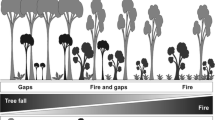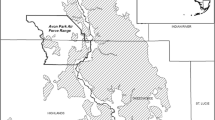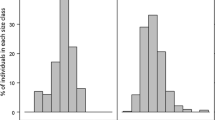Summary
Big Pod Ceanothus (Ceanothus megacarpus) is an obligate seeder after fire; Laurel Sumac (Rhus laurina) is primarily a resprouter after fire. Both species commonly occur together in mixed stands and are dominant members of the coastal chaparral of southern California. We compared the mean survival of post-fire seedlings of each species during the first summer drought after fire and found C. megacarpus to have a mean survival of 54% while R. laurina had a mean survival of only 0.1%. Rooting dephs were similar between species but predawn water potentials and leaf temperatures were higher for R. laurina seedlings. Leaf temperatures for R. laurina reached a mean value of 46.8° C on hot, summer days, about 5° C higher than seedlings of C. megacarpus. By the end of the first growing season, 92% of all C. megacarpus seedlings had suffered herbivory compared to only 17% of all R. laurina seedlings. Herbivory did not appear to be the immediate cause of seedling mortality. Transect data indicated that full recovery of prefire species composition and density at our study site was likely but the mode of recovery was different for the species examined. R. laurina recovered primarily by sprouting, C. megacarpus totally by seedling establishment and a third species, Adenostoma fasciculatum (chamise), by a combination of sprouting and seedling establishment. We attribute the higher mortality of R. laurina seedlings to the greater sensitivity of its tissue to water stress. It may be that differential survival of shrub seedlings and differential modes of reestablishment after fire play an important role in maintaining species diversity in the chaparral communities of coastal, southern California.
Similar content being viewed by others
References
Axelrod DI (1973) History of the mediterranean ecosystem in California. In: Castri di F, Mooney HA (eds) Mediterranean Type Ecosystems: Origin and Structure. Springer, Berlin Heidelberg New York, pp 225–277
Axelrod DI (1977) Outline of California vegetation. In: Barbour MG, Major J (eds) Terrestrial Vegetation of California. John Wiley & Sons. New York, pp 139–193
Barnes FJ (1979) Water relations of four species of Ceanothus. MS thesis. San Jose State Univ, CA.
Bazzaz FA (1979) The physiological ecology of plant succession. Ann Rev Ecol Syst 10:351–371
Biswell HH, Gilman JH (1961) Brush management in relation to fire and other environmental factors on the Tehama deer winter range. Calif Fish Game 47:357–389
Carlquist S, Hoekman DA (1985) Ecological wood anatomy of the woody southern Californian flora. IAWA Bull 6:319–347
Christensen NL, Muller CH (1975) Relative imprortance of factors controlling germination and seedling survival in Adenostoma chaparral. Am Midl Nat 93:71–78
Comstock JP, Mahall BE (1985) Drought and changes in leaf orientation for two California chaparral shrubs: Ceanothus megacarpus and Ceanothus crassifolius. Oecologia (Berlin) 65:531–535
DeSouza J, Silka PA, Davis SD (1986) Comparative physiology of burned and unburned Rhus laurina after chaparral wildfire. Oecologia (Berlin) 71:63–68
Gibbens RP, Schultz AM (1963) Brush manipulation on a deer winter range. Calif Fish Game 49:95–118
Grubb PJ (1977) The maintenance of species-richness in plant communities: the improtance of the regeneration niche. Biol Rev 52:107–145
Hanes TL (1971) Succession after fire in the chaparral of southern California. Ecol Monogr 41:27–52
Heusser L (1978) Pollen in Santa Barbara Basin, California: a 12,000-yr record. Geo Soc Am Bull 89:673–678
Horton JS, Kraebel CJ (1955) Development of vegetation after fire in the chamise chaparral of southern California. Ecology 36:244–262
Jacks PM (1984) The drought tolerance of Adenostoma fasciculatum and Ceanothus crassifolius seedlings and vegetation change in the San Gabriel chaparral. MS thesis, San Diego St Univ, San Diego CA, p 86
Keeley JE (1986) Resilience of mediterranean scrub communities to fire. In: Dell B (ed) Resilience in Mediterranean Ecosystems. Dr. W. Junk, New York, pp 95–112
Keeley JE, Keeley SC (1981) Post-fire regeneration of southern California chaparral. Am J Bot 68:524–530
Keeley JE, Zedler PH (1978) Reproduction of chaparral shrubs after fire: a comparison of sprouting and seeding strategies. Am Midl Nat 99:142–161
Kummerow J, Ellis BA, Mills JN (1985) Post-fire seedling establishment of Adenostoma fasciculatum and Ceanothus greggii in southern California chaparral. Madrono 32:148–157
Miller PC, Poole DK (1979) Patterns of water use by shrubs in southern California. Forest Sci 25:84–98
Mills JN (1983) Herbivory and seedling establishment in post-fire southern California chaparral. Oecologia (Berlin) 60:267–270
Mooney HA, Parsons DJ (1973) Structure and function of the California chaparral — an example from San Dimas. In: Castri di F, Mooney HA (eds) Ecological Studies vol 7, Mediterranean Type Ecosystems. Springer, Berlin Heidelberg New York, pp 83–112
Munz PA (1974) A flora of southern California. Univ Calif Press, Berkeley, CA, p 1086
Musick HB (1972) Post-fire seedling ecology of two Ceanothus species in relation to slope exposure. MA thesis, Univ Calif Santa Barbara, p 22
Poole DK, Miller PC (1975) Water relations of selected species of chaparral and coastal sage communities. Ecology 56:1118–1128
Raven PH (1977) The California flora. In: Barbour MG, Major J (eds) Terrestrial Vegetation of California. John Wiley & Sons New York, pp 109–137
Rundel PW (1981) Fire as an ecological factor. In: Lange OL, Nobel PS, Osmond CB, Ziegler H (eds) Plant Physiological Ecology I, Responses to the Physical Environment. Springer, Berlin Heidelberg New York, pp 501–538
Sampson AW (1944) Plant succession on burned chaparral lands in Northern California. Univ Calif Agric Stn Bull No 685. p 144
Schlesinger WH, Gill DS (1978) Demographic studies of the chaparral shrub, Ceanothus megacarpus, in the Santa Ynez Mountains, California. Ecology 59:1256–1263
Schlesinger WH, Gray JT, Gill DS, Mahall BE (1982) Ceanothus megacarpus chaparral: a synthesis of ecosystem processes during development and annual growth. Bot Review 48:47–117
Scholander PF, Hammel HT, Bradstreet ED, Hemmingsen EA (1965) Sap pressure in vascular plants. Science 148:339–346
Schultz AM, Launchbaugh JL, Biswell HH (1955) Relationship between grass density and brush seedling survival. Ecology 36:226–238
Sokal RR, Rohlf FJ (1981) Biometry. WH Freeman & Co, San Francisco, p 859
Vogl RJ, Schorr PK (1972) Fire and manzanita chaparral in the San Jacinto Mountains, California. Ecology 53:1179–1188
Weibe HH, Brown RW, Barker J (1977) Temperature gradient effects on in situ hygrometer measurements of water potential. Agron J 69:933–939
Weibe HH, Brown RW (1979) Temperature gradient effects on in situ hygrometer measurements of soil water. Agron J 71:397–401
Wellington AB (1984) Leaf water potentials, fire and the regeneration of mallee eucalyptus in semi-arid, south-eastern Australia. Oecologia (Berlin) 64:360–362
Wells PV (1969) The relation between mode of reproduction and extent of speciation in woody genera of the California chaparral. Evolution 23:264–267
Zedler PH (1977) Life history attributes of plants and the fire cycle: a case study in chaparral dominated by Cupressus forbesii. In: Mooney HA, Conrad CE (eds) Proc Symp on the Environmental Consequences of Fire and Fuel Management in Mediterranean Ecosystems, USDA. For Ser Gen Tech Rep Wo-3. pp 451–458
Zedler PH, Gautier CR, McMaster GS (1983) Vegetation change in response to extreme events: the effect of a short interval between fires in California chaparral and coastal scrub. Ecology 64:809–818
Author information
Authors and Affiliations
Rights and permissions
About this article
Cite this article
Frazer, J.M., Davis, S.D. Differential survival of chaparral seedlings during the first summer drought after wildfire. Oecologia 76, 215–221 (1988). https://doi.org/10.1007/BF00379955
Received:
Issue Date:
DOI: https://doi.org/10.1007/BF00379955




